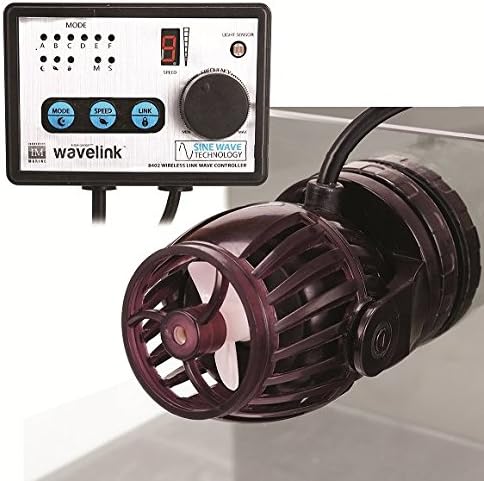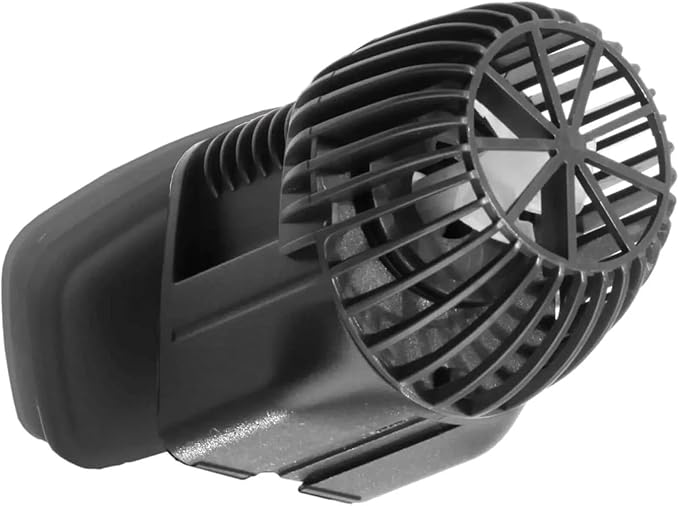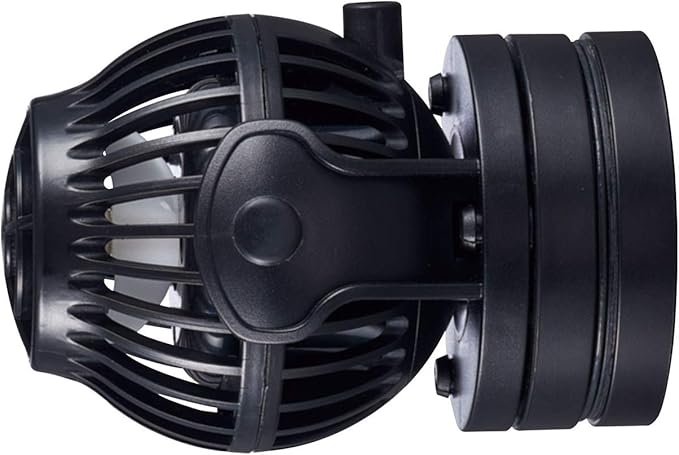Disclaimer: This page contains advertisements and/or affiliate links. We receive compensation from clicks and/or purchases made through these links. Though we may not have tested the specific product(s) mentioned, we do our best to recommend products that are beneficial to our visitors.
A Complete Guide to Flow for Reef Aquariums
Last updated on November 23rd, 2023

Reef Tank Flow
There are a variety of factors when determining the ideal saltwater aquarium flow. To start, reef tanks have different flow needs than FOWLR tanks. Reef tank flow, is also highly dependent on the type of coral you are keeping. For example, SPS coral require significantly higher flow to thrive, where LPS or soft corals typically need the flow to be much lower. Additionally there are different types of flow, including direct, gyre and turbulent flows. These can lead you to decide which powerhead or wavemaker is best for your tank.

What is flow in Saltwater Aquariums?
Flow in a reef tank or FOWLR aquarium is the water movement in the tank by a piece of equipment. Flow is typically measured in gallons per hour (gph) or litres per hour (lph). The type of flow, or the way the water moves such as pulsing direct flow, etc. is also a very important factor.
Flow is important is because it helps remove gases from the water that would otherwise cause harm to fish, corals, and invertebrates. When fish breath, they take in Oxygen and exhale Carbon Dioxide. The CO2 that is exhaled will build up in the water and eventually affect the chemical balance in the tank, including PH and alkalinity. This change in PH and alkalinity will eventually have a cause coral to die. Not to mention the lack of oxygen will kill the fish and invertebrates.
Another benefit of higher water flow is nutrient transport. Higher water flow moves waste and rotting food from the sand and rock to the water column and surface. This lets filters and overflows pull the waste out of the tank, helping to manage nitrates, and lead to a far more stable reef tank.
If you want to understand more about how flow in your reef tank is important, check out this video from Marine Depot.
How much Flow for do I need for FOWLR Tanks?
Fish only with live rock (FOWLR) aquariums require far less flow than reef tanks since the fish are generally not as dependant on flow as coral. The flow in a FOWLR tank is primarily just to keep oxygen in the water, which can often be done with something as basic as an air stone. Additionally, since mose FOWLR tanks have aggressive and/or dirty fish such as puffer fish, it is a good idea to keep high enough flow to get the waste off of the bottom of the tank.
Most beginners to the saltwater aquarium hobby will start with a FOWLR tank and eventually add corals, which frequently die or do not thrive as expected. Unfortunately, when doing this, there is often very little thought to upgrading the wavemakers and powerheads for better flow in the saltwater aquarium. If this is the case for you, I recommend starting to look into higher flow so that the tank does not need to undergo changes later.
What is the Minimum Turnover or Flow Rate for Saltwater Aquariums
Turnover refers to the number of times the entire water volume of your aquarium is moved. If you have a 50 gallon aquarium, and you hav a powerhead with a flow rate of 200 GpH (Gallons per Hour), the turnover rate would be 200GpH / 50G = 4 times per hour.
Now that you know how to calculate turnover rate in the aquarium, what is the minimum amount needed? The minimum recommended turnover rate for a FOWLR aquarium is between 10 and 20 times per hour. So if you have a 50 gallon aquarium, you should aim to have at between 500 and 1,000 gallons per hour of flow at a minimum.
While you may be able to get away with 10 times turnover, I strongly encourage you to aim for 20 times turnover or more. Aiming for the higher end of the "minimum" or "low" flow rates gives you a safety net in the case of equipment failure. Other considerations include obstacles such as rocks or decorations in the way of the water flow, or even just in case of too many fish leading to larger amounts of gas exchange needed. Just don't get too carried away. If the flow is so high that the fish can't swim, it's too much.
Like many other areas in the saltwater aquarium hobby, there are some exceptions. Specialty tanks, like jellyfish or seahorse tanks will need less flow, closer to the 5 times turnover. The low flow rate is because these fish are poor swimmers and high flow will lead to injury or death. With poor swimming fish, I suggest that you do some research and determine what flow is best for the fish. Remember that longer tanks will also have less flow in the center than directly in front of the wavemaker, meaning you may be able to have the best of both worlds.
How much Flow do I need for Reef Tanks?
Reef tanks have additional gas exchange, nutrient transport and other flow related needs. These needs strongly depend on the types of corals you want to keep in your reef tank. Proper flow is one of the most important components, along with lighting, to success or failure when keeping coral, especially SPS and LPS coral.
Flow Rate for LPS and Soft Corals
Every species of coral is a little different and you should do your research before purchasing and placing your corals in your reef tank. Most soft and LPS corals will do best in low to medium flow reef tanks. This would be anywhere between 20 and 40 times turnover. If you choose more flow, these corals should be placed out of direct flow from pumps, wavemakers, and powerheads. If the corals are closed or not doing well, then try to reduce flow rate, or move them to a lower flow area, blocked by rock or other obstacles in your reef.
There are some ways to know if you have too much flow based on the coral as well. For example, if torch or hammer coral are hitting their own skeletons, the flow is too high and will lead to the death of the coral. If any coral look like a tree in a hurricane, leaning too far, the flow is likely too much directly on them. You may want to either position the flow to go above or beside the coral better, or reduce the flow.
Flow Rate for SPS Coral
Similar to soft and LPS corals, every species of SPS coral is different and you should do research before adding these coral to your reef tank. Most SPS corals will do well between 40 and 100 times turnover. This wide fluctuation in flow is mainly due to the different variations of coral. Acropora, for example, usually need higher flow rates than pocillopora coral. If the polyps are not extending, it is likely that this coral needs more light or water flow. SPS coral like acropora frequently like being directly in the water flow and rarely have issues with too much flow, unless placed too close to a powerhead. Other SPS like pocillopora and stylophora prefer the flow to be around them and not at them.
Types of Flow
Laminar Flow or Constant Flow
Laminar flow, often known as constant flow, is usually created by powerheads and pumps. Laminar flow is far less popular for reef tanks as is creates areas where waste can settle. This is because the constant flow usually has an area where the flow is low or that there is no flow. These spots, known as dead spots, are where waste builds up and turns into nitrates and phosphates.
There are some good uses for laminar flow pumps however. The cases where I use constant flow pumps include my SPS tank where I simply needed more flow along the back of the tank and for the acropora at the top. With some pumps creating random flow, and these constant flow pumps acting as a supplement to them for more flow, I see better acropora growth and overall health. Another good use case is for near the bottom, back, or near dead spots in the reef tank. This would help prevent buildup of waste and improve the health of the saltwater aquarium.
I also use constant flow, or laminar flow pumps in my fish and coral quarantine tanks. Since these are short term aquariums, they don't need anything special in terms of flow patterns. In fact, most high end flow pumps are likely too much for these tanks anyway. So these low cost pumps are usually more than enough.
Finally, FOWLR tanks are likely perfectly fine with laminar flow. Wile the fish may like some variation, they will be okay with this type of flow if need be.
Suggested Laminar Flow Pumps
Gyre or Oscillating Flow
Gyre flow is a back and forth motion, usually created by a small surge that will bounce off the opposite wall of the aquarium, and then be pushed back again. This type of flow will create large amounts of force in back and forth motions. This motion creates a lot of movement in the tank, and helps reduce dead spots.
Gyres are great at creating "sheets" of flow and help keep all of the water in the reef moving. They are especially nice for reef tanks that have hammers and torch coral to get indirect flow to the coral, and great waving polyps. Making gyres a really good addition to LPS reef tanks.
For SPS dominated reef tanks, or just higher flow reef tanks in general, gyre wavemakers can be used to add flow in addition to the turbulent flow we will talk about shortly. But gyres can also be used along the back wall and bottom of a bare-bottom reef tank to add flow, remove dead spots, and improve detritus removal.
Suggested Gyre Flow Pumps
Turbulent Flow
Turbulent flow is the crashing of water flow to create randomized flow patterns. The random pattern leaves nearly no dead spots. Being randomized, turbulent flow is often best for moving waste buildup from the bottom of the tank. Turbulent flow is often said to be the best flow for coral health as it will best aid in nutrient transport and better match the ocean.
Turbulent flow can be difficult to get in your reef tank without specific, and often more expensive, wavemakers. That being said however, it seems that the prices of these wavemakers has been coming down with smaller companies creating their own versions of the higher end pumps.
Though not as random or strong as the Vortech, turbulent flow can be created a few other ways. One way to create turbulent flow is by cycling powerheads on and off frequently and with "random" or different on-off times throughout the day. Letting the pumps be on at the same times and some seemingly random combinations of which pumps are on or off throughout the day. Another option is combining multiple oscillating flows, at different rates. The combination of both of these would lead to even more turbulence and randomized flow. However, by the time you purchase the equipment and put in this amount of work, you would likely be better off to purchase the nicer wavemakers.
Suggested Turbulent Flow Pumps

Conclusion:
Determining the Best Flow for your Reef Aquarium
Using the above information, if you have an LPS and Soft Coral dominated aquarium, you may want to consider using gyre flow for keeping the water moving without being too strong. For SPS dominated reef tanks, you may want to use turbulent flow to create randomized patterns in the reef tank and then add gyres and constant flow pumps to fill in the gaps you need. Mixed reef tanks can be tricky. For mixed reefs, medium to low turbulent flow may be best and then adding constant flow for the SPS area near the top of the reef.
As you can see, every type of flow has a use case, and unfortunately every coral has different specific needs. Hopefully this was able to shine some light on the different types of flow, use cases, and even suggestions for the pumps that can help you achieve these goals.
Recommended Reading:
About the Author
John Krenzer

John is a Software Engineer with a passion for saltwater aquariums, as well as the founder and president of Reef Stable. He started in the aquarium hobby as a child with a 20 gallon freshwater aquarium. His interest in aquarium life grew and in 2008, John set up his first saltwater aquarium.
Today, John maintains an over 300 gallon reef tank system, consisting of a 120g reef and a 210g reef. These large tanks are contained within the same system, sharing a sump as a means to reduce total maintenance and increase total water volume.
John writes articles for the blog as a means to learn about more reef aquarium topics. These articles act as a reference for the readers as well as himself. John updates these articles frequently to provide additional information or make corrections as new information becomes available.
If you would like to request an article, tank tour article, or to collaborate, let me know via the Contact Me Page!


















Social Media